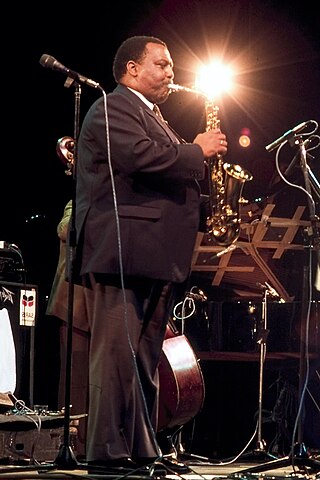
Ray Anderson is an American jazz trombonist. Trained by the Chicago Symphony trombonists, he is regarded as someone who pushes the limits of the instrument, including performing on alto and soprano trombone. He is a colleague of trombonist George E. Lewis. Anderson also plays sousaphone and sings. He was frequently chosen in DownBeat magazine's Critics Poll as best trombonist throughout the late 1980s and early 1990s.

Cecil McBee is an American jazz bassist. He has recorded as a leader only a handful of times since the 1970s, but has contributed as a sideman to a number of classic jazz albums.

Howard Lewis Johnson was an American jazz musician, known mainly for his work on tuba and baritone saxophone, although he also played the bass clarinet, trumpet, and other reed instruments. He is known to have expanded the tuba’s known capacities in jazz.

Arthur Murray Blythe was an American jazz alto saxophonist and composer. He was described by critic Chris Kelsey as displaying "one of the most easily recognizable alto sax sounds in jazz, big and round, with a fast, wide vibrato and an aggressive, precise manner of phrasing" and furthermore as straddling the avant garde and traditionalist jazz, often with bands featuring unusual instrumentation.

Edgar Gómez is a Puerto Rican jazz double bassist, known for his work with the Bill Evans Trio from 1966 to 1977.

Oliver Lake is an American jazz saxophonist, flutist, composer, poet, and visual artist. He is known mainly for alto saxophone, but he also performs on soprano and flute. During the 1960s, Lake worked with the Black Artists Group in St. Louis. In 1977, he founded the World Saxophone Quartet with David Murray, Julius Hemphill, and Hamiet Bluiett. Lake worked in the group Trio 3 with Reggie Workman and Andrew Cyrille. Lake has appeared on more than 80 albums as a bandleader, co-leader, and side musician. He is the father of drummer Gene Lake. Lake has been a resident of Montclair, New Jersey.

Robert Berg was an American jazz saxophonist.

The Count Basie Orchestra is a 16- to 18-piece big band, one of the most prominent jazz performing groups of the swing era, founded by Count Basie in 1935 and recording regularly from 1936. Despite a brief disbandment at the beginning of the 1950s, the band survived long past the big band era itself and the death of Basie in 1984. It continues under the direction of trumpeter Scotty Barnhart.

Charles Daniel Richmond was an American jazz drummer who is best known for his work with Charles Mingus. He also worked with Joe Cocker, Elton John and Mark-Almond.

George Andrew Cables is an American jazz pianist and composer.

Yōsuke Yamashita is a Japanese jazz pianist, composer and writer. His piano style is influenced by free jazz, modal jazz and soul jazz.

Lonnie Plaxico is an American jazz double bassist.
Harold Ashby was an American jazz tenor saxophonist. He worked with Duke Ellington's band, replacing Jimmy Hamilton in 1968. In 1959, he recorded backing Willie Dixon on the latter's first album, Willie's Blues.

Joe Chambers is an American jazz drummer, pianist, vibraphonist and composer. He attended the Philadelphia Conservatory for one year. In the 1960s and 1970s, Chambers gigged with many high-profile artists such as Eric Dolphy, Charles Mingus, Wayne Shorter, and Chick Corea. During this period, his compositions were featured on some of the albums on which he appeared, such as those with Freddie Hubbard and Bobby Hutcherson. He has released fifteen albums as a bandleader and been a member of several incarnations of Max Roach's M'Boom percussion ensemble.
Billy Harper is an American jazz saxophonist, "one of a generation of Coltrane-influenced tenor saxophonists" with a distinctively stern, hard-as-nails sound on his instrument.
Jeffrey Lee Hirshfield is an American jazz drummer.
Ronnie Burrage is an American jazz drummer. His style draws from jazz, funk, and soul.
Victor Lewis is an American jazz drummer, composer, and educator.
Mike Richmond is an American jazz bassist.
John Stubblefield was an American jazz saxophonist, flautist, and oboist.













